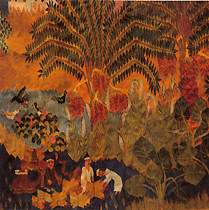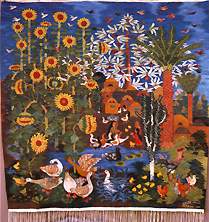|
SECOND
GENERATION WEAVERS
It
was in 1972 that Suzanne Wissa Wassef decided to form her
owngroup of weavers. For this purpose Ramses built her a large
room at the other side of the garden away from the workshops
of the first generation. At first, Suzanne's natural choice
was to invite the children of the first generation weavers
to join her project. Many of these children had spent their
earliest years sitting beside their mothers at the loom. To
keep them busy, they would often be given bits of wool to
weave on small looms.
 Palm Tree (detail) - 1989
Palm Tree (detail) - 1989 |
Suzanne
soon discovered however that they imitated the adults' designs
knowing that these had already pleased the Wissa Wassefs.
She often told the children, "I want
you to bring out what you feel, not what your parents are
doing." The lack of spontaneity in their work moved
Suzanne to disband her newly formed group and to replace them
with a whole new group of children who had not been exposed
to weaving at all. Their challenge, and that of their teacher,
was to become free from the natural impulse to imitate by
using the technical skills of weaving to find fresh interpretations
of the work.
|

|
 Sunflowers - 1991
Sunflowers - 1991 |
When
Suzanne began her work with these children, she made an extra
effort to free them from a desire to merely imitate nature.
Unlike the first generation, the second generation were made
aware from the start of the characteristic details which they
wanted to represent.
Here
she describes her aspirations for the weavers; "I
wove from the age of eight to sixteen and discovered that
the technique had many possibilities. The more I wove, the
more I discovered how freely one can express oneself on the
loom. It was my aim since then to initiate in the weavers
this sense of free expression and unfolding magic."
Working with this in mind, the results were indeed surprising.
Suzanne found that once the children had learned to think
for themselves, they were able to create whole scenes and
broad landscapes, something that had taken their parents much
longer to achieve.
The
second generation were able to devote more effort to finding
new forms and personal styles. Also interesting to add is
the fact that this generation's development took place under
different social and economic conditions. The weavers are
generally financially well-off compared to the other villagers.
Their homes, though simple, are clean and all their needs
are provided for. Today, Suzanne continues her effort with
28 weavers ranging from the ages of fourteen to twenty-eight.
|
|